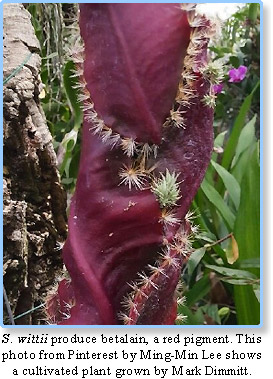Selenicereus wittii (2019)
By Pat Mahon (May 2019)
Pat Mahon (May 2019)
Not many cacti can claim to enjoy wet, hot and humid conditions. Generally speaking, when we think of cacti, we think of very dry and arid environments. Of course, there are epiphytic cacti that may enjoy some wetter conditions, but to think there is a cactus that exists just above the high water mark on the sides of trees in swamps and near rivers is crazy. Selenicereus wittii has even gone as far as creating its seeds filled with air, so that water can disperse them.
Not surprisingly, this cactus, along with many others in the family Cactaceae, have adapted to abiotic factors. Furthermore, being a relative of Cereus, a genus noted for night-blooming cacti, it has also adapted to being pollinated solely by nighttime pollinators, such as hawkmoths.
S. wittii is found in regions of the Igapo forests of western and northwestern Brazil, a very unique biome to understand. Due to frequent inundation by freshwater in these forests and swamps, diversity is limited to species that can tolerate or even proliferate with the seasonal flooding.
Cacti do not seem very likely to be found in swamps, and in fact, these swampy biomes have some of the harshest conditions in which plants live. Selenicereus wittii seems to succeed by floating its seeds where it can latch upon the side of a tree and begin its life just above the water.
 The stems of the cactus are very leaflike and tightly press onto a tree’s trunk. In situ, some of these cacti continue their lives on lifeless trees without shade and must endure the full, scorching sun. They live on by producing extra betalain, a red pigment created by cacti and many succulents. Though betalain is an ill-understood plant pigment, it is believed to carry anti-fungal properties that come in handy when relative humidity is very high!
The stems of the cactus are very leaflike and tightly press onto a tree’s trunk. In situ, some of these cacti continue their lives on lifeless trees without shade and must endure the full, scorching sun. They live on by producing extra betalain, a red pigment created by cacti and many succulents. Though betalain is an ill-understood plant pigment, it is believed to carry anti-fungal properties that come in handy when relative humidity is very high!
Selenicereus wittii is still quite rare in cultivation. It seems to favor growing only attached to a wood mount or other epiphytic mounting technique, such as a large totem or tree fern block. High humidity or frequent misting seem to be paramount for longevity and possibly for any chance of flowering.
August to December are considered the drier months in the Amazon Basin, but in cultivation in the Northern Hemisphere, we typically observe late fall into winter as the time to withhold some watering. S. wittii has been reported to bloom in April, June, July and October. So it is quite opportunistic when it wants to flower.
Since it is impractical to grow outside USDA Zone 10+ unless you have a humid part of a greenhouse, we can instead simply admire and further understand how and why cacti continue to be the champion extremophile plants.
Sources:
University of Connecticut Department of Ecology and Evolutionary Biology – http://florawww.eeb.uconn.edu/200800139.html
New York Botanical Garden – Science Talk, In Search of the Flowers of the Amazon –
http://www.nybg.org/blogs/science-talk/2014/03/in-search-of-the-flowers-of-the-amazon/
